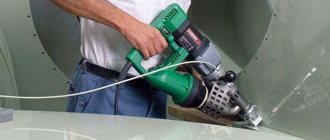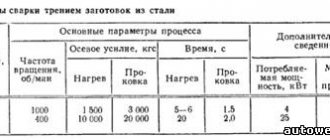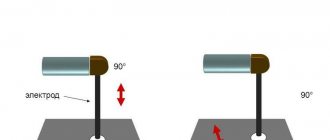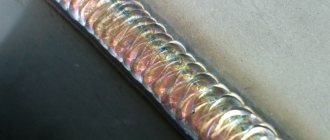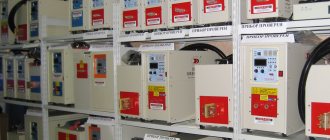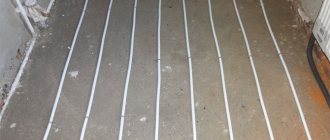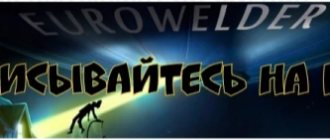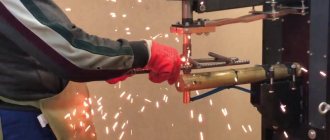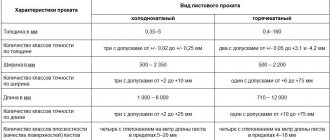Polymer materials are increasingly entering the world around us, occupying all niches for the use of materials in everyday life and industry. Products in the form of plastic sheets also play an important role here, and since the most common type of plastic material is polyvinyl chloride, PVC sheets surround us literally everywhere.
Technological diagram for welding PVC fabrics
Based on this prevalence, welding PVC fabric with your own hands is a very common task and may be required literally at any moment. It is especially important that the process of such work with plastic material is not complicated and does not require special skills and abilities, and the devices are not structurally complex, which means their cost is not high.
This design, which is undemanding for high-tech production, even allows craftsmen to make a fully functional home-made apparatus for such purposes.
The essence of technology
Welding PVC film or fabric provides high seam strength and is effective in use. Fixation in the direction of rupture for such material is much better. PVC welding ensures a tight connection and allows the material to be used for almost any purpose.
Depending on the principle of joining the material, all welding methods can be combined into three main groups:
- Bonding due to a chemical reaction.
- Soldering due to physical and chemical influence.
- Mechanical connection using threads or fittings applied to the product (for PVC pipes).
Canvases and parts of any size, thickness and diameter can be glued.
An example of a chemical bond is cold welding of film with adhesive, during which the polymer softens and forms a strong seal after curing. Physico-chemical soldering involves a temperature effect on the material. The joining principle is similar: the consistency and structure of the canvas or product are changed and then restored, and the parts are connected at the molecular level.
Area of use of canvases
Polymer fabrics have a number of unique properties, thanks to which they have become widespread and universally recognized as the No. 1 material for the manufacture of many types of products. The main advantages of PVC fabrics:
- moisture resistance, due to which it is used in waterproofing structures and wherever water-repellent properties of the canvas are required;
- almost complete chemical inertness, which allows the material to work in aggressive environments, while having a significant service life;
- not exposed to solar radiation - the canvas does not fade and does not change properties when exposed to the open air for a long time;
- insensitivity to temperature changes and tolerates very low temperatures well without cracking or deforming;
- in the most difficult operating conditions (aggressive environment plus mechanical loads) it has a service life of at least 5-10 years.
Being essentially an “all-weather” material, films and sheets made from such a polymer at the same time have a small weight - they can be easily transported, stored, they are easy to install, and, if necessary, dismantle and then reinstall.
The multilayer structure of polymer materials makes PVC fabric resistant to UV light
All this makes PVC fabric indispensable in any household, be it industrial production or domestic needs. And for minor repairs or fastening large panels into one, PVC welding is successfully used. And the scope of use of materials of this type is very wide.
We recommend! How to weld titanium in argon
The main areas of application of PVC fabrics:
- production of awnings and pavilion coverings - everywhere today you can see stalls, parking lots, exhibition pavilions covered with polyvinyl chloride fabric;
- industrial sector - warehouse hangars, production workshops, workshops and gas stations, airplane and helicopter hangars, etc.
- Car awnings deserve special mention - they cover the bodies of 4 out of 5 today's trucks and trailers, as well as for boats;
- protective covers - swimming pools, gazebos, temporary platforms and all types of tents.
- various types of advertising products, including large areas - banners, billboards, banners, big boards, etc.
In connection with the last point, a whole small private business has even developed for the production of advertising media - to fulfill orders, entrepreneurs often use homemade banner welding, made on the basis of an air pump and an air curtain (fortunately, this is structurally simple).
The excellent waterproofing properties of the material allow it to be used as a pool bottom
Due to the absence of complex technological processes and the low cost of equipment, welding of PVC film has become widespread, including independently using certain tools.
Working with an automatic machine (device): technology and recommendations
When the film is welded with a special apparatus, it is necessary to monitor the air temperature in the room. It should be 15-20 degrees at a hot air flow temperature of 350-500 degrees. Exceeding these indicators leads to deterioration in the quality of the seam and deformation of the material.
The device moves at a speed of about 2 meters per minute if the additional weight is 10 kg. The optimal distance between the nozzle and the axis of the pressure roller is 45 millimeters on average, with a maximum extension of the nozzle beyond the edge of 1-2 millimeters. Every 200 meters of connection it is necessary to check the quality of the seam.
The procedure looks like this:
- One of the canvases is rolled out longitudinally and first fixed with tension to prevent wrinkles on the surface. The ends are secured first, then the long side.
- The second part is stretched and overlapped with the first.
- The welding machine is aligned along the seam line, and a weight is placed on the pressure roller.
- The nozzle is installed between the blades, after which the apparatus begins to move.
- During the gluing process, the operator monitors the smooth movement of the pressure roller and adherence to the trajectory of the device.
During the welding process, the seam area smokes moderately. Small areas of connection and hard-to-reach places are soldered manually with a hairdryer.
Welding PVC fabrics
Various types of fabrics of various grades and characteristics are made from synthetic PVC threads. There are many options for using these materials. These fabrics are used to make workwear and tracksuits, accessories for tourism, bathroom curtains, and furniture upholstery.
Canvases of increased density and greater thickness are used for mounting tents and awnings, which are placed in trade pavilions and markets. Advertising boards are made from some types of PVC materials. They look great and are perfectly decorated with films and photo printing.
The remains of PVC fabrics are connected to each other or welding is used for stronger bonding.
Advantages of vinyl materials
Fabrics made from PVC fibers are waterproof. They are not exposed to aggressive environmental influences, withstand sunlight well, and keep their shape when air temperature changes. Fabrics made from PVC fibers have a long service life of at least 5-7 years. The main point of obtaining PVC products is the connection of blanks from canvases.
Sewing machines are used to sew ordinary products made from PVC materials. When producing billboards and tents, welding of fabrics is necessary. This is the only way to get a great product.
The method of welding PVC synthetic material entirely depends on the thickness of the material and its purpose. There are two ways to connect materials:
- automatic method;
- manual method.
Automatic equipment capable of welding long seams is produced by some European companies, whose representative offices are also located in Russia. The manual method is used if it is necessary to connect small pieces of PVC fabric. Each method uses special technologies.
Automatic methods
The connection of dense tissue occurs using high frequency currents. This method requires special current generators with the required frequencies. The HDTV welding machine is very large, operates in automatic mode with enormous efficiency, and its price is not small. This method is used, as a rule, in certain types of production.
Usually equipment is used for welding PVC with a hot air stream. In this case, first of all, it is necessary to melt the PVC and press the sheets tightly against each other. Some models of equipment are known, for example, from Leister. The rollers press the area of the future seam, the built-in nozzle supplies a hot jet.
Welding proceeds quickly with the appearance of a strong seam. The specialist only monitors the direction of movement of the device. The machine controls temperature changes and the power of the press electronically. The welder needs minimal knowledge to select the necessary equipment settings for welding PVC fabrics.
Most companies, for example, RiverFord, sell relatively cheap, easy-to-use machines. The heating element is manufactured by Leister. In principle, you can use a hair dryer from another manufacturer. The degree of press of the canvas is adjusted by three types of mechanisms. The machine can move perfectly on rollers and can be used to join seams of various shapes.
How does manual welding (hair dryer) work?
When gluing the film with a hair dryer, a rolling roller based on Teflon or silicone is used, which prevents the molten material from sticking during rolling. To ensure the accuracy and quality of the seam, you must follow certain recommendations:
- Correctly adjust the temperature regime of the device, taking into account the composition of the material and the manufacturer’s recommendations.
- Perform a test seam on excess material and ensure its quality.
- Use a nozzle with a diameter of 20 millimeters and rollers 20-40 millimeters wide for horizontal seams.
Types of welding machines
For the process of welding PVC profiles, special welding machines are used. All welding machines can be classified:
1. By the number of welding heads: a welding machine can have one, two, four or even 6 or 8 welding heads. Accordingly, in one cycle single-head welding will weld only one corner, two-head welding will weld two corners, and four-head welding will weld four corners. a six-head machine will allow you to weld an impost into a frame simultaneously with welding 4 corners (an impost is a window element dividing a window or doorway).
SL6 Q – automatic six-head welding machine for welding rectangular structures with simultaneous direct welding of the impost into the frame
2. According to the design features, welding machines can be free-standing or as part of a welding and stripping line, can be vertical or horizontal, with in-line welding heads or forming a rectangular perimeter, with diagonal or parallel convergence of heads, with fixed or variable (from 0. 2 to 2 mm) thickness of the weld deposit.
3. In terms of productivity, welding machines can have a standard or shortened welding cycle. Shorter welding cycles mean higher productivity.
An example of a fast cycle welding machine is the SL4-FS. Servo drives allow profiles to be brought together at an adjustable speed, which is controlled by the program. The result is faster welding cycle times, higher productivity and stronger fillet joints.
Also, increased productivity can be achieved by increasing the temperature and/or area of the welding mirror and the ability to weld identical perimeters in two layers (two circuits at the same time).
4. In terms of functionality. Single-function machines perform only one technological operation - PVC welding. Multifunctional machines perform several technological operations, for example, drilling, milling, and welding of imposts.
5. According to the degree of automation, welding machines can be divided into manual (desktop), standard and automatic welding machines. Standard welding refers to free-standing single-head and double-head welding machines, on which the stacking and positioning of workpieces is done manually. Welding machines have CNC axial control, which allows the welding heads to be positioned according to a given size, and all the necessary parameters for welding each profile on these machines are programmed once.
Welding machines on the Russian market are represented by manufacturers from Europe, Turkey and China. Some manufacturers offer only a few models of welding machines, while others have a wider range of models.
Let's look at the main types of welding machines using the example of the FIMTEC line, starting with standard machines, time-tested and proven to be unpretentious and reliable, and ending with the latest generation automatic welding machines with the latest unique technologies.
Welding with rod
In certain cases, film or PVC fabric is welded with filler material in the form of a welding rod. When working with parts whose thickness is less than 4 millimeters, preliminary edge preparation is not necessary. To ensure that the material is welded evenly, a 1-mm gap is left at the top of the weld.
From the point of view of mechanical strength, the best characteristics are shown by butt joints. It is not recommended to overlap welding - with the same thickness of the sheets, the strength will be approximately 6 times less.
When performing welding work, it is necessary to control the correct placement of the additive relative to the weld surface. For unplasticized PVC, the additive is installed at a right angle. A sharper angle increases the consumption of filler material and causes bending of the rod inside the weld. An angle greater than 90 degrees increases the likelihood of the rod breaking after cooling. The optimal rod angle for plasticized PVC is 120 degrees.
A stream of hot air is applied with oscillating movements simultaneously to both the edges and the filler material. The speed depends on the air temperature and the diameter of the rod. Preheating the base material and additive speeds up the process. The so-called high-speed connection is used when working with flat parts and cylindrical products with extended seams. The diameter of the rod is selected taking into account the geometry of the seam, the thickness of the base material, processing speed and requirements for connection reliability. Typically, the root of the welds is filled with a 2 mm rod, after which a rod with a diameter of 3 or 4 millimeters is laid.
What's the result?
As can be seen from the above description, the widespread distribution of polyvinyl chloride sheets very often poses the task of using welding to fasten parts of a product or minor repairs to fabric - these can be sheets of polymer film, a car awning or a pump membrane and many other products around us.
And thanks to the low requirements of welding technology, it is quite possible to do the work with your own hands - using purchased equipment or even a home-made device.
The main welding method is hot air
The process technology is simple and can be described in just a few words. A stream of hot air is directed onto the surfaces to be fastened (joints, seams), which melts the material and turns it into a monolithic structure. To securely set the two canvases, the heating area must be pressed down with a rubber roller.
The PVC welding temperature is maintained at around 700 degrees, which ensures the formation of a reliable monolithic type weld and prevents decomposition of the plastic due to overheating.
In this case, the joint does not have the classic appearance of a seam, but is a monolithic layer of the same material, only of greater thickness. Thanks to this, the joints are practically not subject to destruction under mechanical loads, like seams from other types of joints.
Servo welding machines
In classic welding machines, profile compression is carried out by pneumatic cylinders, which imposes a number of technical restrictions on the welding process, since compression is performed with a constant force that cannot be adjusted.
In machines with servo drives, the convergence and compression of the profile can be controlled by CNC, which opens up fundamentally new horizons in PVC profile welding technology. For example, in the case of the SL4-FS machine, this is an accelerated (up to 50%) welding cycle, and the SL4-FF EVO machine allows you to weld a profile without overlay formation.
Another limitation of classic machines is the thickness of the weld bead. Each thickness requires a locking mechanism that is installed at the factory. The thickness of the overlay is specified by the client when ordering the machine. In the best case, the machine will have two locking mechanisms for a thickness of 0.2 and 2 mm.
With servo-driven machines, a locking mechanism is not required and the weld thickness can be adjusted down to 0 mm. Some European manufacturers, in an unequal struggle with weld deposits, even try to set the thickness to 0 mm in practice, which, however, does not completely solve the problem and turns the limiting knives into consumables. (Completely “defeating” the weld bead and eliminating the need to clean the seam after welding allows machines from the SL-FF , for example, the SL4-FF EVO, which is discussed below.)
Let's take a look at servo-driven machines that deserve special attention.
The SL4-FS is a high-speed four-head welding machine developed by the Italian window equipment manufacturer GRAF Synergy at the request of FIMTEC. The idea for the machine arose as a result of feedback from Russian window manufacturers, whose workshop productivity was limited by the welding cycle time.
Automatic four-head welding machine SL4-FS with accelerated welding cycle
Through the use of servo drives, this machine provides a productivity increase of up to 50% compared to the speed of traditional 4-head welding. Moreover, faster does not mean worse - the SL4-FS is superior to its four-head predecessors in terms of corner joint strength.
The machine is equipped with seven CNC-controlled axes, a precise software setting system for each profile article, and the machine can be programmed using a DXF drawing. An active control system for the welded contour at all stages of the working cycle and along all axes ensures high precision in welding workpieces.
The SL4-FS welding machine has a system for parallel positioning/feeding of heads, automatic correction of profile workpiece height errors up to 0.7 mm and an optional automatic system for rearranging the weld thickness.
SL4-FF EVO is a unique welding machine that allows you to completely eliminate the post-stripping cycle. The PVC profile is welded without overlaying in corner joints. The frame or sash contour welded on this machine does not require stripping or other mechanical processing after the welding cycle. The strip-free welding technology is patented under the trademark “V-Perfect” and is protected by international copyright laws. We devoted a separate article to this machine and the technology at its core.
SL4-FF EVO – automatic welding machine using welding technology without stripping
The SL4-FF EVO has a six-head and eight-head counterpart:
SL6-TFF EVO: simultaneous welding of four corners of the frame at 45° and welding of the impost at 90°
SL8-TFF EVO: simultaneous welding of four frame corners at 45° and welding of two mullions at 90°
